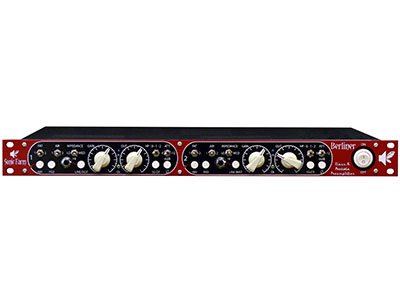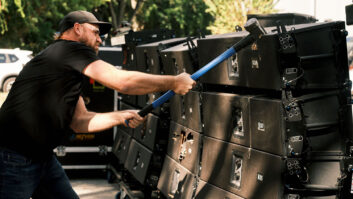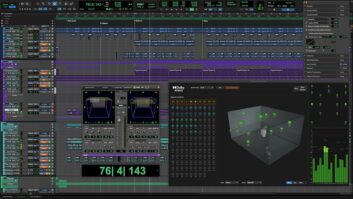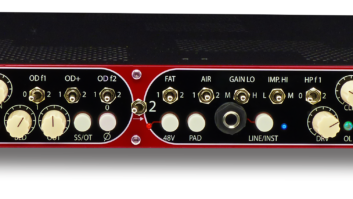
Canadian manufacturer Sonic Farm used the design for the vintage Telefunken V76 mic preamp as a starting point for its superb new mic/line/instrument preamp, the Berliner. Among the changes made to the classic design were substituting EF86/EF806 pentode tubes for the V76’s two cascaded EF804s, which are out of production. The 1RU Berliner’s input transformer also has a 1:20 ratio (the V76’s had a 1:30 ratio), resulting in more sparkly reproduction of transients. And while a second pair of tubes drove the V76’s outputs, Berliner’s Cinemag output transformer is driven by a discrete solid-state buffer; alternatively, you can switch Berliner’s output transformer out of circuit and use the channel’s solid-state, balanced line driver (an IC) for a clearer and less creamy sound.
Here’s Berliner’s signal path, in brief: Two Cinemag transformers serve each channel’s front end, one for the mic input and the other for the balanced line input (bringing the total number of transformers per channel, including that at the output, to three). Each channel’s mic, line and instrument inputs feed the tube gain stage, which is followed by an output-level control and the switchable output (transformer or IC) mentioned above. The preamp’s standard issue features output transformers with a Ni-Fe (nickel-iron alloy) core, but you can order a pure iron transformer (which produces softer high frequencies, for a more vintage-flavored tone) for either or both channels. The unit I tested for this review had pure iron transformers on both channels.
On the Face of It
Berliner’s beautiful front panel is jam-packed with controls that are nevertheless very neatly apportioned (Fig. 1). The control set and layout share much in common with the company’s superb Creamer Plus preamp (reviewed in the December 2013 issue of Mix).
Each of the two channels feature pushbutton switches that respectively activate 48-volt phantom power, pad the mic-input signal 10 dB (before the input transformer), select transformer or solid-state output balancing, and flip phase (at the unit’s output). LEDs light up to respectively indicate the unit is powered up, 48V phantom power is applied, and signal is present (green LED) or clipping (red). The preamp’s power switch is conveniently located on the front panel.
Two large, plastic, chicken-head knobs control input gain and output level, respectively. The input gain pot by itself has a range of about 36.7 dB, but Berliner can provide up to 76 dB of gain for mic signals and 50 dB for instrument and line inputs in total—as much or more than you’ll ever need for any application. The output-level pot attenuates gain before the output buffer and transformer; it doesn’t affect tube gain, and it totally mutes the output signal when turned fully counter-clockwise. A three-way switch attenuates the output of the tube 0, 6 or 12 dB (before the output-level pot); attenuating the tube’s output precludes your having to use the output-level pot near the bottom of its range—where its action is imprecise—when processing hot signals.
Depress the line/instrument pushbutton to receive signal from Berliner’s ¼-inch unbalanced instrument jack (on the front panel) or line input (rear panel). The instrument input sees an input impedance of 3.9MΩ.
A Fat switch lets you select from two alternate corner frequencies for shelving-EQ boost for the bass band, while an Air switch does the same for highs; the three-way switches each have a center position for bypassing their respective filter. The exact corner frequencies aren’t specified because they change as you adjust input gain: As gain is lowered, the currently selected Fat corner frequency is raised and the Air corner frequency is lowered. The shelving filters have 6dB/octave slopes and use the tube gain stage, shunning an extra stage that would otherwise degrade the signal. You can adjust the amount of boost they each provide by adjusting trim pots—two for each channel, accessed by tiny holes in the chassis’ top panel—using a mini-slot or hex screwdriver. (Gain knobs would be more convenient than slotted trims, but there is simply no room on the front panel for more knobs.)
A three-way impedance switch selects alternate impedances for mic input. Another three-way switch selects 160 Hz, 80 Hz or bypass for a 6dB/octave highpass filter.
On Berliner’s rear panel, each channel sports a mic and line input and a line output by way of balanced XLR connectors (six connections in total for the two channels; see Fig. 2). A ground-lift switch, mains fuse and IEC power receptacle (for the provided detachable AC cord) round out the rear-panel’s facilities. Measuring roughly five feet in length, the AC cord is fairly short.
Sonic Farm spared no expense in Berliner’s specification: All I/O connectors are latching, all switches have a sturdy feel and positive action, and the chicken-head knobs have a glide that’s as smooth as silk. Maximum output level is stated to be +32 dBu—blazing hot! The frequency response is 10 Hz to 50 kHz ±3 dB. Harmonic distortion is less than 1-percent below clipping level and decreases rapidly as the unit is driven progressively less.
In the Studio
Mix readers may remember my gushing praise for Sonic Farm’s hyper-lush Creamer Plus preamp and wonder how Berliner’s tone differs. Because Berliner includes a gain pot (feedback loop), it generally sounds less colored than the Creamer Plus. But Berliner sounds anything but clinical.
Berliner sounded outstanding on lead vocals: at once lush, three-dimensional, clear and precise. I generally preferred to use the solid-state output on vocals, as the sound was a little clearer and more focused compared to when using the output transformer. Just boost the input (tube) gain to dial in the amount of velvet you want to add to the talent’s vocals, and lower the output level as needed to prevent clipping downstream.

Next up was a palm-muted electric-guitar vamp, played with a ’62 Strat. The amp was miked from two feet away with a Neumann U 87a set to bi-directional mode. Driving the tube gain stage once again delivered a gorgeous sound: lush, yet brimming with in-your-face detail. Berliner’s output transformer helped mitigate the Strat’s mild inherent glassiness, lending a more creamy tone.
The Fat and Air equalization circuits both sounded absolutely gorgeous: smooth and rich. The FAT2 setting lent a thunderous low end to electric bass guitar, recorded via Berliner’s front panel DI jack. With the tube gain cranked and the solid-state output selected, the sound was huge but not at all boomy or mushy. Switching in the output transformer rounded the track’s transients nicely, providing an alternative tone.
Berliner’s line inputs handled my console’s hot 2-bus levels (+26.5 dBu) with ease and grace. Just be aware that, like with using Creamer Plus, raising an output-level knob past roughly the three o’clock position disguises clipping indication by unjustifiably turning the overload LED’s color from red to green. Running a full mix through the line inputs, the preamp added delicate luster, subtle top-octave sparkle and dimension. It sounded like an extremely light veil around 300 to 400 Hz was lifted and the lead vocal was moved ever so slightly forward. Otherwise, Berliner left the spectral balance perceptually unchanged; the overall effect was that it simply made the mix sound sweeter and a tad more open.
The solid-state outputs sounded best to my ears in 2-bus applications, fully preserving transient reproduction and giving a tighter bottom end than when using the transformer outputs. The bottom line? Whether processing mic, line or instrument signals, Berliner sounds absolutely phenomenal.
Michael Cooper is a recording, mix, mastering and post-production engineer and a contributing editor for Mix magazine.
Product Summary
COMPANY: Sonic Farm
PRODUCT: Berliner
WEBSITE:sonicfarm.com
PRICE: $2,850 CAD (about $2,337 USD) factory-direct
PROS: Sounds superb. Feature-packed. Accepts mic, line and instrument inputs. High maximum gain and headroom. Only one rackspace high.
CONS: Output-gain pot disguises clipping indication when cranked. Short AC cord.







